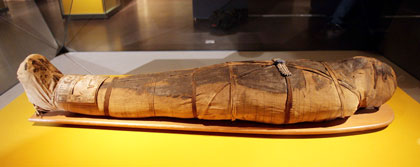A wealth of treasures
The British Museum was founded by an act of the Parliament of UK in 1753, the
first national museum in any country.
The aim was "to gather into one building objects from the whole world, past
and present, so that visitors from across the world could compare the ways in
which different societies had organized themselves and different peoples had
addressed the common problems of humanity," said MacGregor.

A mummy from ancient
Egypt is one of the exhibits.
[newsphoto] |
After at least 253 years of compiling and research, the collection today
allows the whole world to look at what it has made, he said.
The "Treasures" exhibition reflects this global reach and supports the
museum's founding principles. It is one example of the British Museum's
extensive programme of loans across the UK and the world, MacGregor said.
Before its appearance in China, the "Treasures of the World's Cultures"
exhibition had toured Japan and South Korea over the past three years, both of
which turned out to be huge successes, said Jane Portal, assistant keeper of the
British Museum's Department of Asia.
When exhibited in four Japanese cities, including Tokyo, the exhibition drew
more than 1.3 million visitors in October 2003 and August 2004; and in South
Korea, it attracted an average of 3,400 people to the Seoul Art Centre every
day, she said.
Priceless exhibits
With 272 priceless articles, including sculptures, paintings, jewellery,
porcelain, and stone artefacts that have been collected from the world's five
continents by the museum since it was founded in 1753, the grand exhibition
covers a vast span of time from 2 million years ago to the present day.
The treasures on show are divided into 13 parts based on their origins and
dates, such as ancient Egypt, Greece and Rome, Europe in the Middle Ages, and
modern art.
It documents the magnificently diverse expressions created by different
groups and individuals.
Among the exhibits are brilliant examples of Egyptian mummy boards and
portraits, exquisite Assyrian reliefs, marble statuary and coinage from Greece
and Rome. There's also a replica of the famous Sutton Hoo helmet, the Rosetta
Stone from Egypt (a slab dating back to around 200 BC), Islamic Astrolabes,
mosque lamps and hanging scrolls from Asia. Visitors can gaze at plaques from
Benin, a Maori war whistle from New Zealand, drawings by Leonardo and Raphael,
and some prints by Rembrandt and Goya.
It also features the oldest object in the British Museum a stone chopping
tool from Olduvai Gorge, Tanzania, believed to have been made nearly 2 million
years ago and so far the first known technological invention by human beings,
said Jane Portal, who acts as a key co-ordinator for the Beijing exhibition.
Capital Museum has welcomed the treasures on loan from the British Museum
with newly-purchased showcases, each at least 100,000 yuan (US$12,330), which
are hyper-sensitive to changes in temperature and humidity.
Moreover, about 50 guides, including 40 recruited university students who
have received some training at the Capital Museum, will serve the visitors;
electronic audio guides, either in Chinese or in English, are also available.
Guo said that to help promote the knowledge of world art, the Capital Museum
has also arranged six free lectures on the topic, to be delivered by Chinese
scholars, during the exhibition.
Students and senior citizens aged 60 and above can buy the 40-yuan (US$5)
ticket for the special show at a 50 per cent discount.
Guo estimated that more than 400,000 people in Beijing are expected to see 2
million years of history and art with their own eyes.
(China Daily 03/23/2006 page13)